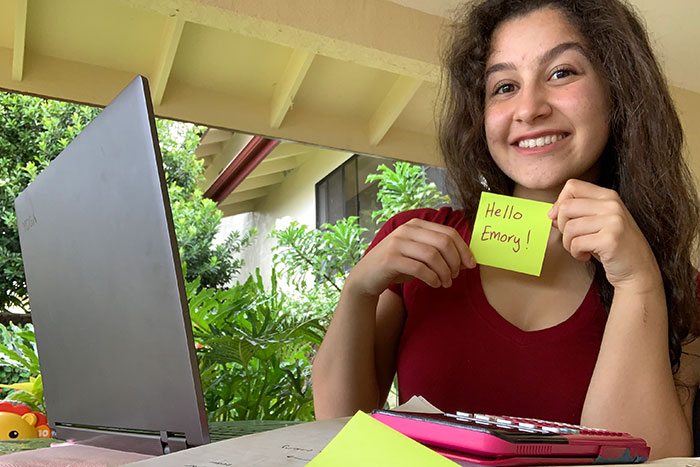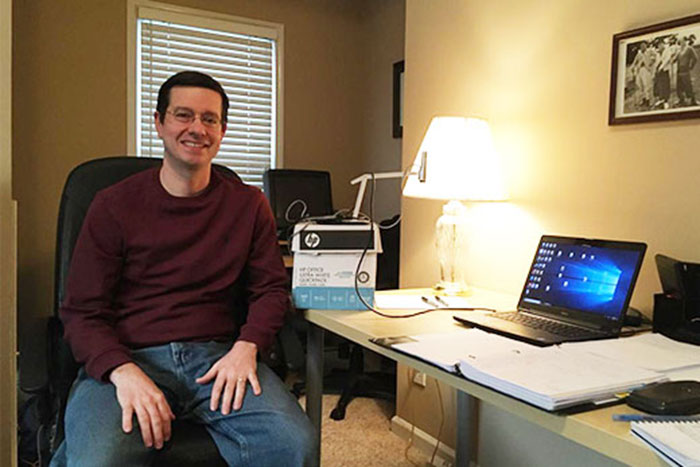Emory entered a new phase of education on March 23 when all graduate and undergraduate classes transitioned to remote learning for the remainder of the spring 2020 semester. The shift — implemented in response to the COVID-19 pandemic — necessitated many changes but did not deter Emory’s mission to create and share knowledge.
“Classes that Click” is a new series showcasing how high-caliber education continues and how many lessons learned will further enhance life at Emory when everyone returns to classrooms together.
In this edition, Tom Bing, senior lecturer and director of undergraduate studies for the Department of Physics, shares how he has expanded his use of technology for a lecture-based class with 110 students.
Sarah Abdul-Ghani, a first-year student in Emory College of Arts and Sciences who is a student in Bing’s class, also shares her perspective as a first-time learner in remote classes. She is a prospective psychology major on the pre-med track.
The course: “Physics for Scientists and Engineers, Part 2” (Physics 152)
“Physics for Scientists and Engineers, Part 2” introduces students to electric and magnetic fields and forces, Gauss’s law, electrical properties of materials, electromagnetic induction, electromagnetic waves and optical phenomena.
Moving toward remote learning
How had you already used technology in class?
Bing: I have always used Canvas (to post my syllabus, homework solutions, practice exams, etc.) and WebAssign as our online homework platform. Each homework assignment also always included items that I coded into WebAssign myself: an essay question and (often) a question directing the students to play around with some sort of online physics simulation. I tried to use computer simulations regularly in lecture, too – the old “picture is worth a thousand words” idea, plus it breaks up the monotony of listening to a 50-minute lecture.
What was one of your primary challenges in shifting to a remote format and how did you meet it?
Bing: The first challenge was simply getting the professional part of my personality past the general “What in the world am I going to do now?” mindset. Once I started digging around in all the resources, stuff started coming together pretty quickly. I decided to shift to an almost completely asynchronous design and record and post my lectures so students can view them at any time. Homework assignments and lab activities are on WebAssign.
The next challenge was deciding where to set the rigor/difficulty level for the remaining weeks. We’re all still committed to offering the best educational opportunities we can. But we faculty have to realize that some of our students will simply not be able to concentrate as efficiently on their academics as we are used to seeing. But I still owe everyone a good product.
Then I realized that academic rigor and grading rigor should be seen as two orthogonal axes, at least in the present circumstances. I can still put just as much deep physics into my lectures and homework as usual. But that does not automatically imply I need to keep my difficult timed exams and the usual distribution of grades they produce. I simply need to trust the standard Emory student to receive the information and take their learning as far as they want.
Abdul-Ghani: My primary challenge was adjusting to the time difference since I live in Hawaii, which is six hours behind Eastern Standard Time. My 10 a.m. classes became 4 a.m. classes and the class that normally started very late in the day now starts at 10 a.m. This was difficult, but having the ability to record Zoom lectures has helped solve a few of my problems. In general, professors are being very understanding.
Putting remote learning into practice
What has been a pleasant surprise about remote learning?
Bing: I’ve always believed that 60% of great university teaching is nothing more than careful, meticulous planning. Think very carefully about precisely how you’re going to present new ideas in class and activate productive, scientifically authentic behaviors in students. An idea in week 3 should be handled a certain way because I know what’s coming in week 10. The other 40% of great teaching is much more interpersonal and artful.
I’ve been pleasantly surprised that about the same 60/40 proportion still seems to hold in remote learning mode. My job skills and responsibilities have not hugely changed. I’m seeing the same payoff for all my careful preparation and class planning, even if the end product is now a nice set of lecture videos and deep student questions that are asked over email instead of in person.
Abdul-Ghani: I am pleasantly surprised by the creativity of some professors to continue teaching classes that are not suited for online learning. My labs are now online. My indoor climbing class professor had to be more creative. We are asked to take activity pictures and record journal entries to submit on Canvas.
How are you staying engaged with your students or classmates and professors?
Bing: I’ve set up discussion threads on Canvas, invited emailed questions and held Zoom videoconference office hours. It’s important that students know those resources are there. I am monitoring people’s online homework submissions more than I would during a standard semester. If someone’s work starts to lag or several assignments are missed, perhaps sending a “Can I help?” message could help get things back on track sooner rather than later.
Abdul-Ghani: I am constantly on Facetime with my classmates and will email or set up a Zoom conference to stay engaged with my professors. I hardly feel isolated.
Lessons for the future
What’s one lesson you’ve learned during this transition? How will you use that lesson when you return to a face-to-face classroom setting?
Bing: It’s much more awkward to talk to myself in an empty room as I make a lecture video than I expected. The deeper lesson behind that observation is that, once I can teach in person again, I should pause and be thankful for the big lecture halls filled with students and the lines outside during my office hours. I want to remember what it was like during this semester when all that constant in-person energy got taken away, and be more thankful for the flurry of interaction that’s typical on Emory’s campus.
Abdul-Ghani: I have learned that my professors genuinely care about their students and not to take this for granted. I have learned to be more appreciative of the privileges I didn’t know I had. I may begin to look forward to morning classes, study sessions in the library and even simply sitting next to my classmates.
In addition to focusing on the university’s educational mission, Emory experts are on the front lines of the pandemic – caring for patients, researching possible treatments and vaccines and sharing knowledge to help inform and prepare the public. Visit Emory’s COVID-19 page for the latest updates.


